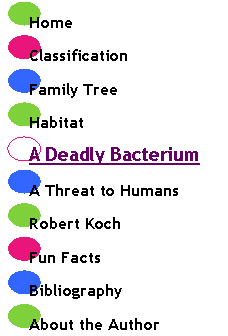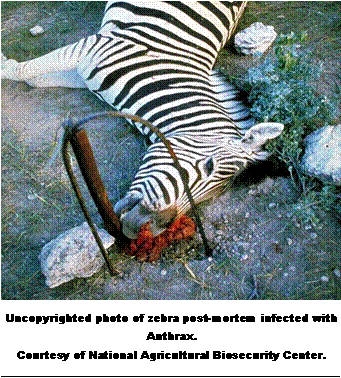
|
The Deadly Past, Present, and Future |
|
The animals that are most commonly infected with anthrax are cattle, sheep, goats, horses, rats and birds. More often than not, the disease is contracted when an animal consumes contaminated soil. Unfortunately for the animals, once the spores reach its bloodstream, a new generation of bacteria are born. This fact is what lead to the discovery that a specific microorganism could cause a specific disease in an animal. Herbivores are much more susceptible to the deadliness of the disease, but carnivores also face mortality. Seen is that if an animal suddenly dies without many symptoms except for a possible brief period of fever and disorientation, the animal should be tested for the presence of anthrax. Symptoms that can be seen post-mortem that suggest presence of anthrax spores include bloody fluid leaking from the nose, mouth, and anus, lack of rigor mortis, and bloating that sets in quickly and completely. |

|
In domesticated animals, a live attenuated vaccine was one of the first vaccines ever developed. A live attenuated vaccine is a vaccine created through use of a virus (in this case, an anthrax virus) that is no longer able to infect. While they are no longer able to infect organisms, the virus is now able to help immunity against infection. This vaccine lead to the development of a non-living vaccine which eventually lead to the licensed protein-based vaccine that has been approved by the FDA since the 1970s. Today, the vaccine is recommended to people who have occupational hazards of contracting anthrax. This includes mail-people, farmers, and wool-workers. For those who have occupational hazards of coming in contact with anthrax, three shots are required in order to effectively immunize against infection. After the three initial shots are administered, annual booster are required to keep immunity levels sufficiently high.
|
|
Click here to link back to multipleorganisms.net and search for different organisms. |
|
Interested in learning more about the fine institution I attend? Click here to link to the University of Wisconsin—La Crosse’s home page. |